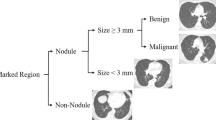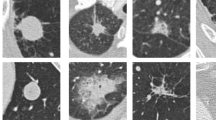Abstract
Lung cancer is the second most prominent cancer in men and women, and it is also the leading cause of cancer-related mortality.If lung cancer is diagnosed early, when it is minuscule and has not spread, it is preferable to be adequately treated. A non-invasive low-dose Computed Tomography (CT) scan can detect abnormal patches in the lungs that could be cancerous. It is proposed that machine learning and pattern classification be used to identify and categorize lung cancer from CT scans. Pattern classification algorithms like deep learning can categorize input data into various classes based on the input’s characteristic features. A novel deep learning framework formulated by the encapsulation of a Convolutional Neural Network (CNN) and a Capsule Neural Network (CapsNet) called LCD-CapsNet, leveraging the capabilities of these networks to minimize vast amounts of data and achieve spatial invariance for lung cancer detection and classification using CT images is proposed. The primary objective of the proposed method is to create algorithms that would classify and examine images from a dataset to determine whether or not a patient had or posed a danger of developing lung cancer. The Lung Image Database Consortium (LIDC) datasets are utilized to assess this deep learning model, from which 4335 images were collected for the training and testing pipeline. The results demonstrated that LCD-CapsNet outperforms CapsNet, with an average Precision of 95 %, Recall of 94.5 %, F1-Score 94.5 %, Specificity 99.07 %, Area Under the Curve of 0.989, and Accuracy 94 % of benign and malignant data.












Similar content being viewed by others
Data Availability
LIDC-IDRI data are publicly availabe
References
Abubeker KM, Baskar S (2022) A Machine Learning Strategy for Internet-of-Things-Enabled Diabetic Prediction to Mitigate Pneumonia Risk. In: In 2022 10th International Conference on Reliability, Infocom Technologies and Optimization (Trends and Future Directions)(ICRITO) (pp. 1-6). IEEE
Abubeker KM, Baskar S (2022) Wireless sensor and wireless body area network assisted biosensor network for effective monitoring and prevention of non-ventilator hospital-acquired pneumonia. Frontiers in Sustainable Cities 4
Adebisi OA, Ajagbe SA, Ojo JA, Oladipupo MA (2022) Computer techniques for medical image classification: a review. Intelligent Healthcare, pp 19–36
Adu K, Yu Y, Cai J, Owusu-Agyemang K, Twumasi BA, Wang X (2021) DHS-Capsnet: Dual horizontal squash capsule networks for lung and colon cancer classification from whole slide histopathological images. Int J Imaging Syst Technol 31(4):2075–2092
Afshar P, Naderkhani F, Oikonomou A, Rafiee MJ, Mohammadi A, Plataniotis KN (2021) MIXCAPS: A capsule network-based mixture of experts for lung nodule malignancy prediction. Pattern Recognit 116:107942
Afshar P, et al. (2020) 3D-MCN: A 3D Multi-scale Capsule Network for Lung Nodule Malignancy Prediction. Sci Rep 10 (1):7948. https://doi.org/10.1038/s41598-020-64824-5
Ajagbe SA, Oki OA, Oladipupo MA, Nwanakwaugwum A (2022) Investigating the efficiency of deep learning models in bioinspired object detection. In: 2022 International Conference on Electrical, Computer and Energy Technologies (ICECET) (pp. 1-6). IEEE
Al-Huseiny MS, Sajit AS (2021) Transfer learning with GoogLeNet for detection of lung cancer. Indones J Electr Eng Comput Sci 22(2):1078. https://doi.org/10.11591/ijeecs.v22.i2.pp1078-1086
Al-Yasriy HF, Al-Husieny MS, Mohsen FY, Khalil EA, Hassan ZS (2020) Diagnosis of lung cancer based on CT scans using CNN. IOP conf. Ser Mater Sci Eng 928(2)
Alzubaidi L, Zhang J, Humaidi AJ, Al-Dujaili A, Ye D, Al-Shamma O, Santamaría J, Fadhel MA, Al-Amidie M, Farhan L (2021) Review of deep learning: concepts, CNN architectures, challenges, applications, future directions. J Big Data 8:53
Armato SG, et al. (2011) The lung image database consortium (LIDC) and image database resource initiative (IDRI): A completed reference database of lung nodules on CT scans. Med Phys 38(2):915–931
Asuntha A, Srinivasan (2020) A Deep learning for lung Cancer detection and classification. Multimed Tools Appl 79:7731–7762
Avanzo M, Stancanello J, Pirrone G, Sartor G (2020) Radiomics and deep learning in lung cancer. Strahlentherapie und Onkol 196(10):879–887
Aydın N, Çelik Ö, Aslan AF, Odabaş A, Dündar E, Şahin MC (2021) Detection of lung cancer on computed tomography using artificial intelligence applications developed by deep learning methods and the contribution of deep learning to the classification of lung carcinoma. Current Medical Imaging 17 (9):1137–1141
Bhandary A, Ananth Prabhu G, Rajinikanth V, Palani Thanaraj K, Satapathy SC, Robbins DE, Shasky Charles, Zhang Yu-Dong, Tavares JMRS, Sri Madhava Raja N (2020) Deep-learning framework to detect lung abnormality – A study with chest X-Ray and lung CT scan images. Pattern Recognit Lett 129:271–278
Bushara AR, Vinod Kumar RS (2022) A deep learning-based lung cancer classification of CT images using augmented convolutional neural networks, Electronic Letters on Computer Vision and Image Analysis 21(1). https://doi.org/10.5565/rev/elcvia.1490
Causey JL, Zhang J, Ma S, et al. (2018) Highly accurate model for prediction of lung nodule malignancy with CT scans. Sci Rep 8(1):1–12
Doi K (2007) Computer-aided diagnosis in medical imaging: historical review, current status and future potential. Comput Med Imaging Graph 31(4-5):198–211
El-Askary NS, Salem MAM, Roushdy MI (2019) Feature extraction and analysis for lung nodule classification using random forest. In: Inproceedings of the 2019 8th International Conference on Software and Information Engineering, pp 248–252
Ghani T, Oommen JB (2021) On utilizing 2D features from 3D scans to enhance the prediction of lung cancer survival rates. Pattern Recognit Lett 152:56–62
Guo Z, Xu L, Si Y, Razmjooy N (2021) Novel computer-aided lung cancer detection based on convolutional neural network-based and feature-based classifiers using metaheuristics. Int J Imaging Syst Technol 31(4):1954–1969. https://doi.org/10.1002/ima.22608
Huidrom R, Chanu YJ, Singh KM (2022) Neuro-evolutional based computer aided detection system on computed tomography for the early detection of lung cancer. Multimed Tools Appl 81:32661–32673
Jain S, Salau AO (2019) An image feature selection approach for dimensionality reduction based on kNN and SVM for AkT proteins. Cogent Eng 6 (1):1599537
Kalaivani N, Manimaran N, Sophia S, Devi DD (2020) Deep learning based lung cancer detection and classification, IOP conf. Ser Mater Sci Eng 994(1). https://doi.org/10.1088/1757-899X/994/1/012026
Khan A, Sohail A, Zahoora U, Qureshi AS (2020) A survey of the recent architectures of deep convolutional neural networks. Artif Intell Rev 53 (8):5455–5516
Koresh HJD, Chacko S, Periyanayagi M (2021) A modified capsule network algorithm for oct corneal image segmentation. Pattern Recognit Lett 143:104–112
Kumar SS, Nithila EE (2016) Lung cancer diagnosis from CT images using CAD system: a review. Int J Biomed Eng Technol 21(4):311–321
Lennartz S, et al. (2021) Texture analysis of iodine maps and conventional images for k-nearest neighbor classification of benign and metastatic lung nodules. Cancer Imaging 21(1):1–10
Makaju S, Prasad PWC, Alsadoon A, Singh AK, Elchouemi A (2018) Lung cancer detection using CT scan Images. Procedia Computer Science 125:1877–0509
Manju BR, Athira V, Rajendran A (2021) Efficient multi-level lung cancer prediction model using support vector machine classifier. In: IOP Conference Series: Materials Science and Engineering (Vol. 1012, No. 1, p. 012034). IOP Publishing
Mobiny A, Van Nguyen H (2018) Fast CapsNet for Lung Cancer Screening. In: Frangi A., Schnabel J., Davatzikos C., Alberola-López C., Fichtinger G. (eds) Medical Image Computing and Computer Assisted Intervention – MICCAI 2018. MICCAI 2018. Lecture Notes in Computer Science, vol 11071. Springer, New York
Mobiny A, et al. (2021) Memory-Augmented Capsule network for adaptable lung nodule classification. IEEE Trans Med Imaging:1–11. https://doi.org/10.1109/TMI.2021.3051089
Naqi SM, Sharif M, Lali IU (2019) A 3D nodule candidate detection method supported by hybrid features to reduce false positives in lung nodule detection. Multimed Tools Appl 78:26287–26311
Nasser IM, Abu-Naser SS (2019) Lung cancer detection using artificial neural network. International Journal of Engineering and Information Systems (IJEAIS) 3(3):17–23
Nithila EE, Kumar SS (2016) Segmentation Of lung nodule in CT data using active contour model and Fuzzy C-mean clustering. Alex Eng J 55(3):2583–2588
Nithila EE, Kumar SS (2017) Automatic detection of solitary pulmonary nodules using swarm intelligence optimized neural networks on CT images. Eng Sci Technol Int J 20(3):1192–202
Nithila EE, Kumar S (2019) Segmentation of lung from CT using various active contour models. Biomed Signal Process Control 47:57–62
Olalekan A, Jain S (2021) Informatics in Medicine Unlocked Adaptive diagnostic machine learning technique for classification of cell decisions for AKT protein. Informatics Med Unlocked 23:100511. https://doi.org/10.1016/j.imu.2021.100511
Pang S, Zhang Y, Ding M, Wang X, Xie X (2020) A deep model for lung cancer type identification by densely connected convolutional networks and adaptive boosting. IEEE Access 8:4799–4805
Parveen SS, Kavitha C (2014) Classification of lung cancer nodules using SVM Kernels. Int J Comput Appl 95(25)
Phani Kumar M, Dutta S, Murmu NC (2021) Tool wear classification based on machined surface images using convolution neural networks. Sādhanā 46:130
Polat H, Mehr HD (2019) Classification of pulmonary CT images by using hybrid 3D-deep convolutional neural network architecture. Appl Sci 9(5)
Ramana K, Kumar MR, Sreenivasulu K, Gadekallu TR (2022) Early prediction of lung cancers using deep saliency capsule and Pre-Trained deep learning frameworks. Front Oncol 12(June):1–13. 10.3389/fonc.2022.886739
Sabour S, Frosst N, Hinton GE (2017) Dynamic routing between capsules. Adv Neural Inf Process Syst,pp 3856–3866
Salama WM, Shokry A, Aly MHA (2022) Generalized framework for lung Cancer classification based on deep generative models. Multimed Tools Appl 81:32705–32722
Salau AO, Min M (2019) Feature extraction: A survey of the types, techniques, applications. In: 5th IEEE International Conference on Signal Processing and Communication (ICSC), Noida, India, pp158–164. https://doi.org/10.1109/ICSC45622.2019.8938371
Saleh AY, Chin CK, Penshie V, Al-Absi HRH (2021) Lung cancer medical images classification using hybrid cnn-svm. Int J Adv Intell Informatics 7 (2):151–162. https://doi.org/10.26555/ijain.v7i2.317
Shafi I, et al. (2022) An effective method for lung cancer diagnosis from CT scan using deep Learning-Based support vector network. Cancers (Basel) 14 (5457):1–18
Shen W, Zhou M, Yang F, Dongdong Y, Di D, Yang C, Zang Y, Tian J (2017) Multi-crop Convolutional Neural Networks for lung nodule malignancy suspiciousness classification. Pattern Recognit 61:663–673
Siegel RL, Miller KD, Fuchs HE, Jemal A (2021) Cancer statistics. CA Cancer J Clin 71(1):7–33
Song QZ, Zhao L, Luo XK, Dou XC (2017) Using deep learning for classification of lung nodules on computed tomography images. J Healthcare Eng 2017(8314740):7
Sori WJ, Feng J, Godana AW, Liu S, Gelmecha DJ (2021) DFD-Net: lung cancer detection from denoised CT scan image using deep learning. Front Comput Sci 15(2)
Tang B, Li A, Li B, Wang M (2019) Capsurv: Capsule network for survival analysis with whole slide pathological images. IEEE Access 7:26022–26030
Thakur SK, Singh DP, Choudhary J (2020) mLung cancer identification: a review on detection and classification. Cancer Metastasis Rev 39(3):989–998
Wu P, Sun X, Zhao Z, Wang H, Pan S, Schuller B (2020) Classification of lung nodules based on deep residual networks and migration learning. Comput Intell Neurosci, vol 2020
Yu H, Li J, Zhang L, Cao Y, Yu X, Sun J (2021) Design of lung nodules segmentation and recognition algorithm based on deep learning. BMC Bioinforma 22(314):1–20. https://doi.org/10.1186/s12859-021-04234-0
Yu H, Zhou Z, Wang Q (2020) Deep learning assisted predict of lung cancer on computed tomography images using the adaptive hierarchical heuristic mathematical model”. IEEE Access 8:86400–86410
Acknowledgment
The authors acknowledge the National Cancer Institute and the National Institutes of Health for their contributions to the development of the LIDC/IDRI database, which is free and open to the public. There was no specific grant awarded for this study by any government, commercial, or nonprofit organization.
Author information
Authors and Affiliations
Corresponding author
Ethics declarations
Conflict of Interests
The authors declare that they have no conflict of interest.
Additional information
Publisher’s note
Springer Nature remains neutral with regard to jurisdictional claims in published maps and institutional affiliations.
Vinod Kumar R.S. and Kumar S.S. are contributed equally to this work.
Rights and permissions
Springer Nature or its licensor (e.g. a society or other partner) holds exclusive rights to this article under a publishing agreement with the author(s) or other rightsholder(s); author self-archiving of the accepted manuscript version of this article is solely governed by the terms of such publishing agreement and applicable law.
About this article
Cite this article
A.R., B., R.S., V.K. & S.S., K. LCD-Capsule Network for the Detection and Classification of Lung Cancer on Computed Tomography Images. Multimed Tools Appl 82, 37573–37592 (2023). https://doi.org/10.1007/s11042-023-14893-1
Received:
Revised:
Accepted:
Published:
Issue Date:
DOI: https://doi.org/10.1007/s11042-023-14893-1




